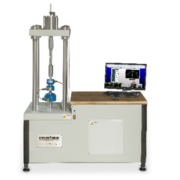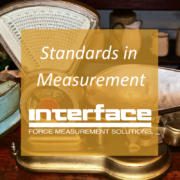Force Measurement is Fundamental in Material Testing
 Material tests are run to determine the quality, durability, and resistance of materials for parts and products. Selecting the right material is critical to performance of a product, system, or part, especially as it relates to the environmental factors. It is also core for adhering to regulatory standards and compliance requirements.
Material tests are run to determine the quality, durability, and resistance of materials for parts and products. Selecting the right material is critical to performance of a product, system, or part, especially as it relates to the environmental factors. It is also core for adhering to regulatory standards and compliance requirements.
Whether it is construction and concrete materials, metals, fabrics, biomaterial, plastics, packaging, or some other matter, material testing is fundamental throughout the entire development lifecycle.
Among the various ways to test materials, force measurement is one of the most important. Common uses of force measurement in material tests include applications to measure hardness, torsion, strength, compression, bending, shear, impact, creep, fatigue, and nondestructive capabilities.
The use of load cells provides an adaptable tool that can be utilized for various types of material tests. Using force measurement sensors help to detect changes in load, which is used to determine the flexibility, strength, or weakness of properties in materials. This is critical for research and quality control.
For example, in metal material testing load cells are frequently used for characterizing and assessing the quality of metallic components and structures. Material test engineers use load cells to accurately measure the tensile strength, compression resistance, and yield properties of metal samples. By subjecting metals to controlled loads and monitoring the metals deformation during tests, Interface load cells provide critical data that informs engineering decisions and quality control processes. Material tests confirm that the metals chosen for products like aircraft structures, automotive components, and sports equipment, meet stringent performance standards. The measurement sensors are also vital for determining the reliability, longevity and safety of metal materials used for any product or part. See other examples of testing in our new Interface T&M Material Testing Overview.
It is the responsibility of a material testing engineer to determine the resilience, safety, and value of materials through mechanical testing, of which material testing is one of the five categories. Ultimately, product designers and original equipment manufacturers (OEMs) rely upon material testing data to ensure their products can withstand the anticipated levels of force during use. They also need to know if the material will stretch or elongate, as well as pinpoint its exact breaking point.
Interface’s robust line of load cells, multi-axis sensors, and data acquisition systems are used for material testing. It is common to have our 1200 LowProfile load cells installed into material testing machines at test labs and onsite. We also supply a variety of miniature load cells and load pins for material testing, depending on the type of equipment and environment used for tests.
High accuracy load cells are essential in material testing due to their precision, versatility, and ability to provide real-time data, which helps researchers and engineers gain a better understanding of a material’s mechanical properties and behavior under different conditions.
If force must be measured, Interface has a solution. This applies to testing materials used for infrastructure, medical devices, aircraft, rockets, vehicles, robotics and consumer goods. As new materials and composites are introduced in revolutionary ways for use in construction, designing light weight products using polymers, and 3D printed components, it is imperative that material tests validate the use case based on high accuracy measurements.
Our force measurement products are being used to gather data from testing materials in applications used for machines, equipment, structures, packaging and more. Here are a few examples of material testing applications.
Inflatable Space Habitat
Inflatable habitats are the newest innovation in the space industry, creating a new interplanetary dwelling for humans to live and work past the Earth’s atmosphere. An innovative space industry company wanted to test the overall design and material of their inflatable habitats by conducting a burst test. Multiple clevises and LP Stainless Steel Load Pins were attached to the in the webbing material that create the inflatable habitat. When pressure was increased within the inflatable habitat, the load pins captured how much force the heavy duty material will hold at specific pressures until it explodes. Interface’s LP Stainless Steel Load Pins successfully measured the amount of force the inflatable habitat could withstand during the burst test.
Material Tensile Testing Load Frame
A customer wanted to conduct a tensile force test on different samples and materials until failure. Materials include plastic, steel, or woven fabric. They wanted to measure tensile strength, yield strength, and yield stress. Interface’s 1200 Standard Precision LowProfile™ Load Cell was installed into the customer’s test frame. The tensile test was conducted, and force results were captured by the load cell and extensometer were synced through the SI-USB4 4 Channel USB Interface Module. These results were then displayed on the customer’s PC with supplied software. With Interface’s force products, the customer was able to determine the tensile strength, yield strength, and yield stress of a variety of different materials.
Material testing is often the first step in any new product development process. With Interface force measurement solutions, our customers can expect industry-leading accuracy, quality and reliability in testing the materials that will go into their next project. Contact us for products used for various test types.
Interface Solutions for Material Testing Engineers
Tensile Testing for 3D Materials
The Aviation Industry Soars Using Interface Solutions








